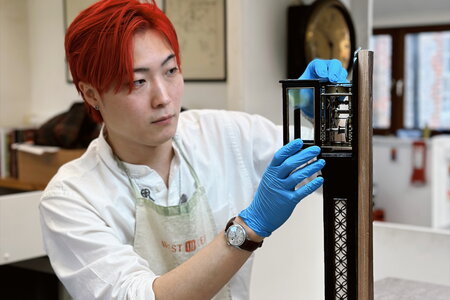-----> Read part 1 here
_____________________________________________________________________________________
Getting started on the Pagoda clock required a detailed and elaborate plan. The object consists of five tiers with over 600 individual parts in the case alone. All of these had to be photographed, measured, catalogued, and cleaned; clearly my work was cut out for me. Every piece is marked with the maker's numerical system detailing how and in what order it should be assembled. My modern system consisting of an Excel spreadsheet, catalogue number, plastic bag, and paper label somehow seems silly when compared with the simplicity of the original. Every screw has to be put back in the same place from which it was taken.
A catalogue number was assigned to each component consisting of a letter to designate the tier from which the part came, a letter to indicate the side, the number of the part, and a sequence number to illustrate how the clock goes back together.The first piece assessed was the finial decoration-in this one component there are 36 pieces, each marked during manufacture with a number and dots establishing a unique place and purpose.

After careful examination, each component was cleaned and dried, wrapped in acid-free tissue, and stored with the catalogue number.

I found a rhythm in the work and aimed to finish a tier a day to stay on schedule. Though it was a pattern repeated several times per hour there were little inconsistencies and surprises that awaited me. I began to find the signature of one "Carter Bowles"-sometimes tucked away beneath petals, and elsewhere quite obviously scratched across large surfaces. A rich story was beginning to unfold.
Minute details became like little rewards and treasures untold, such as this delicate "mistake:" one yellow leaf that should have been blue.
This little subtlety is located on the very bottom tier where the clockwork mechanism protruding from the base is disguised by the contra-rotating blooms.

The flower petals are secured to a steel arbor connected to the main mechanism that runs up through the centre. Once the top bud is unscrewed the flower components are free to slide off one by one-each made to be embraced by the one below. Access to the final tier could only be gained through the flower pot. Once the jewelled foliage was disassembled, I could peer inside and see the machine waiting in the depths.



